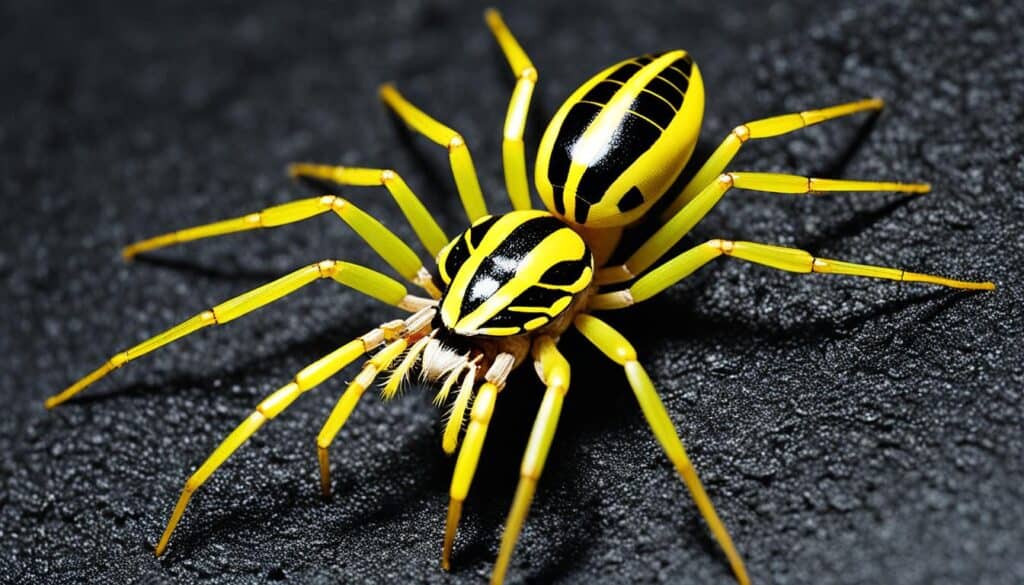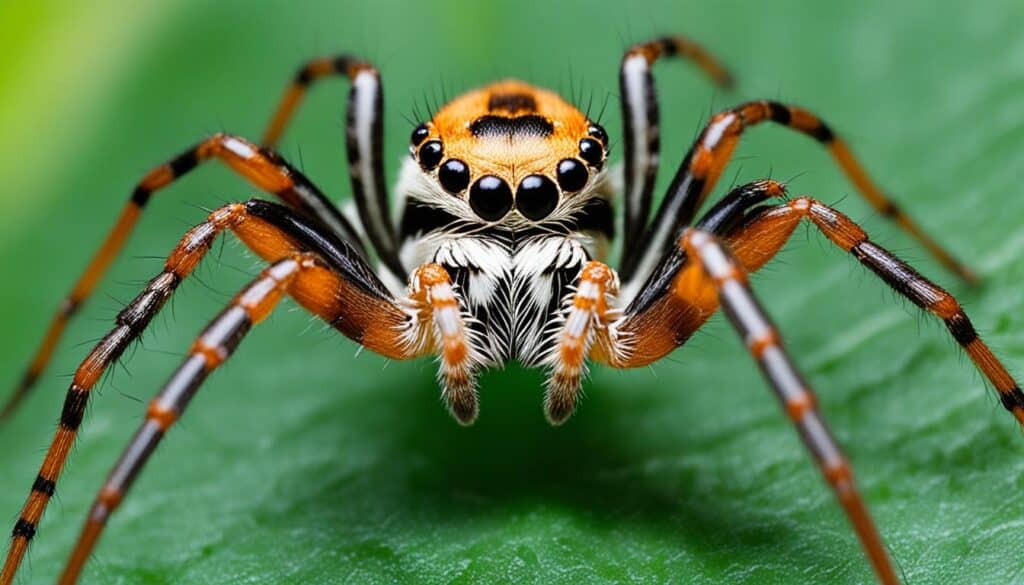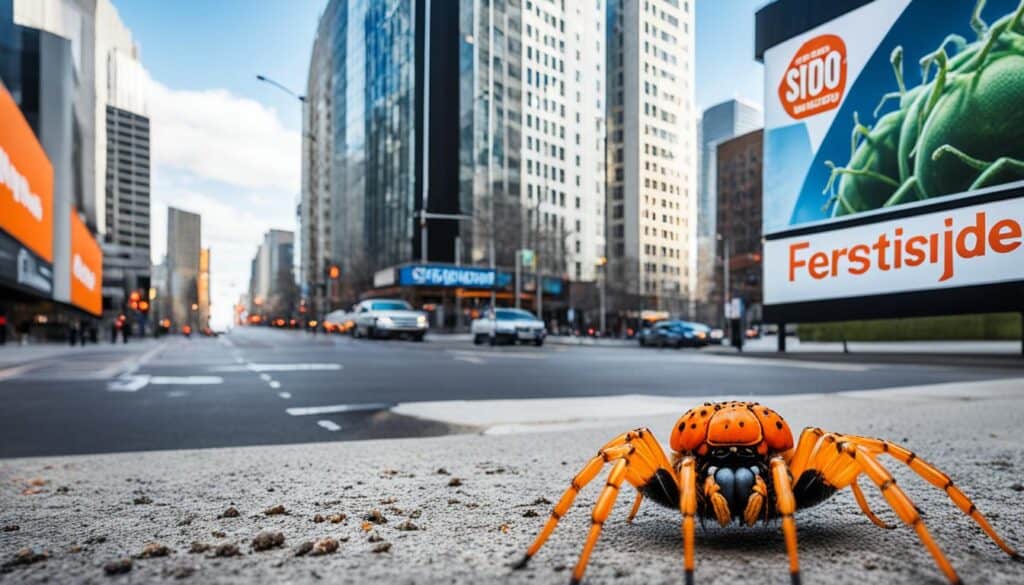Did you know about the Joro spider? It’s a big, colorful spider reaching three inches long. It came to the southern United States recently. Starting in Georgia in 2013, it has spread quickly, even reaching Baltimore.
This invasive spider is easy to spot with its bright stripes. People from Atlanta to Jersey are keeping an eye out. That’s because Joro spiders, from East Asia, adapt well to cold thanks to their high metabolism and strong hearts.
The Joro spider competes with native species for food. Yet, even though they might look scary, they’re not really dangerous to people. Getting bitten by one is rare and only causes a small itch.
These spiders can move around by “ballooning.” This means young spiders use silk threads to glide through the air to new places. They can also catch rides with humans, spreading along the East Coast. The University of Georgia is studying their effects but notes they help control pests.
We’re all wondering how these new spiders will affect our local ecosystems. There’s interest in what long-term effects might happen to our native spiders and the environment.
Key Takeaways
- Joro spiders, native to East Asia, can grow up to three inches long.
- These invasive species have rapidly spread from Georgia to parts of the East Coast.
- Their adaptations make them hardy in cold climates, unlike their relatives.
- Joro spiders use a “ballooning” technique to float to new territories.
- While they are harmless to humans, their impact on native ecosystems remains under study.
Introduction to Joro Spiders
Trichonephila clavata or the Joro spider is the new eight-legged craze in the U.S. It comes from East Asia. Its colors are a stunning mix of yellow and blue-black. Imagine a spider so big, it seems like it could high-five you! These spiders probably hitched a ride to the U.S. in shipping cargo.
The female Joro spiders really stand out. It’s not just their bright yellow color, but their wide leg span of up to four inches. They are masters at weaving, making large, strong webs. In the city, Joro spiders are making their mark, living in different places and moving north.
People have seen Joro spiders from Atlanta to the Carolinas, and even in Baltimore. They have a special way of moving called “ballooning.” They use silk to catch the wind and glide through the air. Sometimes, they even hitch a ride with humans without us knowing it.
Joro spiders don’t just stick to the woods; they like cities too. You might find one in your backyard. These spiders from East Asia are becoming a big deal in America!
Identification and Behavior of Joro Spiders
The Joro spider stands out with its large size and bright pattern. Female Joros are especially noticeable with their long legs and vivid blue-black and yellow bodies. Besides looks, their behaviors are also key to identifying them.
Joro spiders weave huge, up to ten feet wide, webs with a special golden color. These webs look beautiful and are also very effective traps. The webs help identify Joro spiders and tell us about their behavior. Even though they have venom, Joro spiders are usually calm around people. They typically only bite if they feel trapped, and their bites rarely hurt humans.
Joro spiders might pretend to be dead if they feel scared. They seem calm, but they’re very good at spreading quickly. They first appeared in Georgia in 2014. By now, they have moved across several states, moving about 10 miles each year.
They come from East Asia, which has taught them to adapt well. For example, they handle cold better than many spiders. They also use their webs to travel with the wind, a trick called ballooning. This skill helps them move far and fast. Before Joros, there was only one Trichonephila spider species in the Americas.
Even as they spread to places like Florida and Kentucky, Joro spiders keep their Asian traits. They build their webs and look the same no matter where they live. This consistency shows how well they adapt without losing their original habits.
Origin and Spread of Joro Spiders
Imagine walking in Georgia and seeing a big colorful spider. It’s a Joro spider, first seen in Georgia a decade ago. They can travel by air, spreading far and wide. But how did they come to the U.S.?
The most likely answer? International cargo. They are from Japan, Korea, Taiwan, and China. It’s thought they hitched a ride here in shipping containers. They essentially got a free trip.
Since arriving, they’ve spread across many states. You can find them from Oklahoma to South Carolina. They’re not picky about where they live, even in cities.
Their webs are huge, up to 10 feet long. They’re great for catching bugs. That could be good unless you dislike spiders.
University of Georgia researchers have looked into these spiders. They’re venomous but not harmful to us. They can also “play dead” for a minute. Yet, we don’t know how they will affect local ecosystems.
It’s unclear if Joro spiders will move to states like New York and New Jersey. Their ability to spread in colder areas is doubtful. We’ll see where they show up next.
Human Interaction and Public Health
We’ve all been there: seeing a spider at 3 AM and feeling like an athlete. But Joro spiders are a step beyond that. Despite their looks, they’re not a big public health issue. They rarely bite, and if they do, it’s mild like a mosquito’s.
Our fear of spiders is the bigger problem. They might seem scary, but Joro spiders are hardly a threat. Their bites can’t easily break human skin. This fact proves many spider myths wrong. So, when you see one, keep calm. It’s more afraid of you.
Joro spiders are harmless to pets too. Unless you have a spider-hunting mongoose, your pet is safe. They prefer eating flying bugs and small creatures, not pets.
It might seem odd, but knowing about Joro spiders helps us. They look scary but are very peaceful. They avoid people. So, if you spot one, just ignore it and walk by.
Joro Spiders and Native Stepcies
Here’s the thing about Joro spiders: they’re ambitious little critters. They come from East Asia and can grow up to three inches. They arrived in northern Georgia in 2014 and have been spreading quickly. They now live from Atlanta to the Carolinas and southeastern Tennessee. They even made a new home in Baltimore over the last two years.
Now, let’s discuss the elephant—or should I say the spider—in the room. The arrival of Joro spiders brings up lots of questions. They compete with native spiders for food, which could harm local species. Their webs are incredibly effective at catching insects, which might change the food web.
But it’s not all bad news. Joro spiders can become food for local predators. This could help balance their new environments. People are both scared and fascinated by them. We’re still learning if they will harm or help our ecosystems. Their impact is a complex issue that’s still being figured out.
So, what do we do about these invaders? Collaborative efforts are key in dealing with Joro spiders. Using pesticides is a bad idea because it can harm other animals. If you find their webs annoying, just use a stick or broom. Luckily, Joros usually don’t make webs inside houses. It’s important to stay calm and help protect native spiders.




